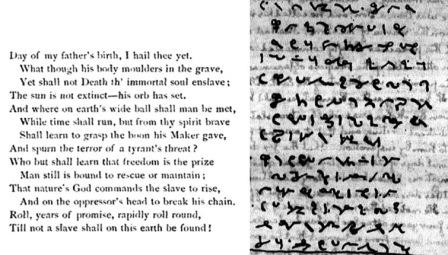By Gwen Fries, Adams Papers
A line in John Quincy Adams’s 1788 diary is the earliest example of his use of English poet John Byrom’s shorthand system. The system replaces words with symbols to make writing faster and, eventually, easier. Six years later, Adams recorded in his diary that his youngest brother, Thomas Boylston, was attempting to teach himself shorthand and noted that he had once endeavored to learn the system, “but soon gave over the pursuit; not having a very high opinion of the utility of the art.”
Later in life John Quincy changed his mind about shorthand’s usefulness, though he did not strictly adhere to the Byrom system. The symbols, some of which are his own variations, appear in his diary more frequently beginning in 1810. John Quincy penned an entire sonnet in shorthand on October 30, 1826. He wrote, “I record it thus that it may be legible only to myself, or to a reader who will take the trouble to pick it out of the short-hand— If it were better poetry I would have written it at full length.”
Though it at first appears to be a page of scribbles, by using a combination of Byrom’s original structure and the hints John Quincy scattered throughout his papers, it is indeed possible to “pick it out.” The linear symbols represent consonants and digraphs; vowels are represented by dots, if at all. If a symbol stands alone, it represents a commonly used word.

Directly translated, the first line of the sonnet (above) reads, “Da f/v m fthrs brth I hl th y.” Once the vowels and commonly used words are filled in, we get “Day of my father’s birth I hail thee yet.” Let’s examine some of the symbols used here. The first symbol in the line is a “d.” If it stood alone, it would mean “and;” however, it is modified by a dot. The placement of the dot reveals what vowel it represents. From top to bottom, the dots represent A E I O U. Because it sits at the top of the symbol, we can read the letters as “da.” The word is “day.” For longer words, several symbols are combined. You can see the green that represented f or v in the second word is repeated in the fourth; in this case, it represents f. The next symbol, in blue, is the digraph th. The orange dash is r, and the yellow line is s. What is written is “fthrs,” obviously, “father’s.” The r and th are repeated in the following word, with a b at the front, “brth,”—“birth.” Note that even though the th arch is flipped upside down, the meaning remains the same.
Using past examples of John Quincy’s shorthand as a guide, you simply need to write out what you know, use context clues, repeat the process fourteen times, and you’ve picked out the sonnet!


